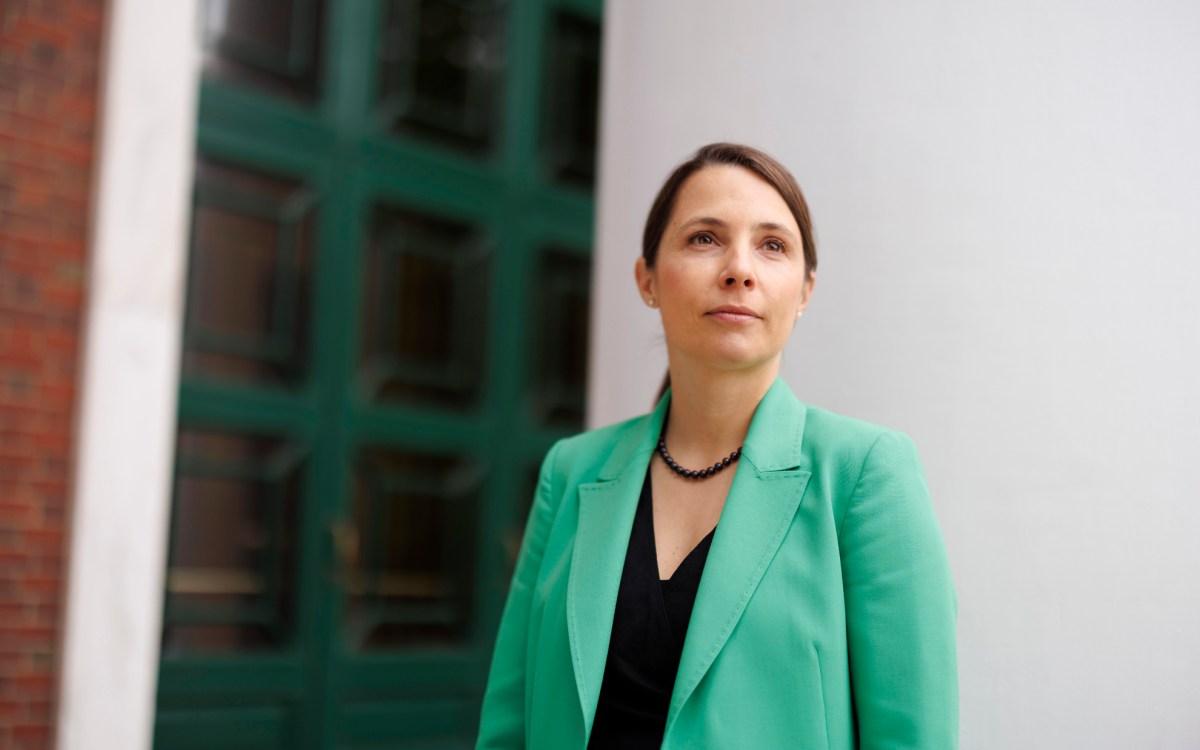
Kris Snibbe/Harvard Staff Photographer
The pause that brings peace and productivity
Business School’s Joseph Badaracco’s new book, ‘Step Back,’ teaches you the art of reflection
Many of us feel time-pressured, tethered to our smartphones so we can stay on top of work and home responsibilities. It can be tough to step off the daily merry-go-round, put our phones, laptops, and to-do lists aside, and find decent chunks of quiet time to reflect on our lives.
In fact, we may not even be sure how.
Yet reflection is important; it gives us a chance to pause and figure out what really matters, especially when struggling with a difficult issue professionally or personally, says Joseph Badaracco, the John Shad Professor of Business Ethics at Harvard Business School, in his new book “Step Back: How to Bring the Art of Reflection into Your Busy Life.”
“We often get advice to reflect, and we often give the advice to reflect. But what is reflection?” Badaracco asks. “And how do busy people find time to reflect?”
To answer this question, Badaracco studied classic works of reflection, including “Meditations” by Roman Emperor Marcus Aurelius, “Spiritual Exercises” by Jesuit order founder Ignatius Loyola, “Essays” by philosopher Michel de Montaigne, as well as many diaries and journals of leaders.
“We often get advice to reflect, and we often give the advice to reflect. But what is reflection?”
In addition, Badaracco interviewed more than 100 managers, ranging from supervisors to CEOs, from 15 countries to learn how busy men and women today find time for reflection. He found that almost all of them do reflect, but they don’t necessarily rely on long periods of solitude. Instead, they practice the art of reflection “in the cracks and crevices of their everyday lives” to help them make better decisions day by day and problem by problem.
Badaracco recommends four design principles for reflection. Like design principles in art and architecture, they don’t explain precisely what to do and when. “That is your call,” he says. What the design principles provide is a template for sound reflection in a hectic world.
1: Aim for good enough
For many of the managers Badaracco interviewed, the biggest obstacle to reflecting was acute time pressure. As one manager said, “I go from commitments at home to commitments at work … I have very little me time.” Others had trouble keeping their thoughts from relentlessly zig-zagging all over the place, or felt restless taking time to sit and think. “I hate feeling idle,” one manager said. “I hate the feeling of not doing anything that I don’t think is productive.”
And some resisted reflecting, saying it was easier to focus on the here-and-now, rather than look down the road where they might be forced to grapple with the uncertainty of the future. “It can be a little frightening because, you know, this is the time when I’m supposed to sit down with a pad of paper and really think ahead, and you’d much rather be busy because it’s so easy to focus on the latest emails,” one manager said. “Some of the crazy busyness is self-imposed.”
But it doesn’t take ironclad discipline, rigid scheduling, or abandoning the laptop for a full hour to overcome these obstacles. It starts with letting go of the idea that we must reflect in a time-consuming or perfect way; instead, we should “aim for good enough,” Badaracco says. Thoughtful reflection is worth doing, even if we fall short of some ideal—and given the busy pace of our lives, “good enough” reflection is a real accomplishment, he says.
How do we aim for good enough? The answer, Badaracco says, is to find an approach that fits comfortably into your life and, even better, involves something you enjoy doing. Some of the managers took advantage of quiet periods when they were doing other things, like exercising, cooking, or commuting to work. “In the car,” one manager said, “I find it really easy to concentrate because there’s nobody talking to me, and you can watch the road, which I think you can do with about half your brain, while the other half is at work.”
About a quarter of the managers relied on occasionally writing out their thoughts, in journals and notebooks or even spreadsheets that compared the pros and cons of a problem.
And reflection doesn’t have to be a solitary act. Some managers sought out meaningful conversations with trusted others, relying on regular calls to their parents or turning to a colleague who, as one manager said, is “the kind of person you go see when you need to talk something through, so you go to their office and close the door.”
2: Downshift occasionally
The first of the three fundamental approaches to reflection has traditionally been called contemplation, or downshifting from time to time. At work, many people tend to focus on output, and their minds act like race car engines, firing on all cylinders at 200 miles an hour to exert the mental power needed to examine problems, figure out solutions, and get things done.
Many of the managers Badaracco interviewed found ways to pause and put their mental machinery into a lower gear, letting their minds unfocus, and resisting the urge to feel continuously productive or decisive. “If something is bothering you about a particular problem, sometimes you have to slow down to recognize it,” Badaracco says.
During a work meeting, rather than staying laser-focused on getting through the agenda, take time to look around the room and pay attention: Do coworkers seem interested or bored? Is the conversation heading in the right direction?
Badaracco describes a range of approaches interviewees followed and recommends people see what works well for them. One approach suggests mental meandering by letting your thoughts, feelings, and attention wander for a few minutes to see where they go. Look up from your computer screen and take a break from accomplishing task after task.
Another suggestion involves simply slowing down physically in order to slow down mentally. One busy executive who managed 1,500 people said when she had meetings away from the office, sometimes she left early to “make my way there slowly” to get a “feel for how things are going.”
Other managers turn to nature. One manager, quoting her father, a farmer, said, “The number of people who can walk outside and just look up is so small.” Hitting the beach or a nature trail in the middle of a workday may not be practical, but taking a short walk outside or even looking out the office window or at an indoor plant can help free up the mind.
And finally, many interviewees made a conscious effort to take a little time to celebrate progress or successes, rather than staying focused only on their list of to-dos. Some did this by praying and thanking God; others kept a journal of things they are grateful for. Marc Andreesen, the high-profile venture capitalist who helped create the Mosaic Web browser, keeps an “anti-to-do list,” which displays everything he has done during the day to feel a sense of accomplishment, confidence, and motivation to continue.
One manager, noting the need to escape what he called the “psychic prison of continuous improvement,” regularly set aside time to celebrate workplace achievements with his staff.
“Reflection is often viewed as a gloomy, serious enterprise, where you ask: Where have I failed, and what should I do next?” Badaracco says. “But you ought to look at the full range of things you have already done, including non-work tasks, and pat yourself on the back occasionally.”
3: Ponder your hard issues
The second fundamental approach to reflection is pondering. This means stepping back and consciously looking at a problem from a variety of perspectives.
The managers Badaracco interviewed did this in a wide range of ways. Some tried to vividly imagine the everyday consequences of choosing among two different options—such as deciding whether to take a new job or stick with a current one. Some doodled their thoughts, some tried to look at a problem from the perspective of someone they admired or someone who might be badly affected by it, and some tried to see if they had feelings or perspectives on the margins of their minds that they were uncomfortable examining.
“Without reflection, we drift.”
A few managers even acknowledged that they talked with themselves, sometimes aloud, to see an issue from a wider perspective.
“It’s about making a conscious effort to look at things from a variety of viewpoints without trying to crack the case or come up with the answer right away,” Badaracco says.
4: Pause and measure up
The third classic approach to reflection involves measuring up. This is particularly relevant when you have to make a decision and act on it. It’s critical to take a few moments to step back and ask yourself which option is best in terms of the standards that others expect you to meet and the standards you have set for yourself, Badaracco says.
The managers Badaracco interviewed took different approaches to this way of reflecting. Some imagined what their professional role models would do. Others followed personal principles or mantras that meant a good deal to them, based on earlier experiences in their lives. Some asked themselves what kind of legacy, however modest, they wanted to leave behind before deciding what to do.
Reflection promotes growth
Reflection, Badaracco says, can enhance your life and your work, if you develop a pattern or mosaic of reflection that meshes with your life and if you occasionally step back further to reflect more deeply.
“Without reflection, we drift,” Badaracco says. ”Others shape and direct us. With reflection, we can understand and even bend the trajectories of our lives.”
This article originally appeared in Working Knowledge.





